Research Proposal: Factors Affecting Dialog Axiata in Sri Lanka
VerifiedAdded on 2023/06/09
|20
|4150
|278
Report
AI Summary
This research proposal investigates the factors contributing to the underperformance of Dialog Axiata, a major telecommunications company in Sri Lanka. It begins by providing background information on Dialog Axiata and highlighting the significance of the research in light of increasing competition and market changes. The proposal outlines key research questions and objectives focused on analyzing the causes of underperformance and recommending potential solutions. A literature review explores business success factors, relevant models and theories, the impact of strategic management, and factors affecting the telecom industry. The proposal also includes a conceptual framework and discusses the research methodology, including the research philosophy, approach, design, data collection, and analysis processes. The research aims to identify the strategic and operational challenges faced by Dialog Axiata and suggest strategies for improvement. Desklib offers a variety of similar solved assignments and past papers for students.
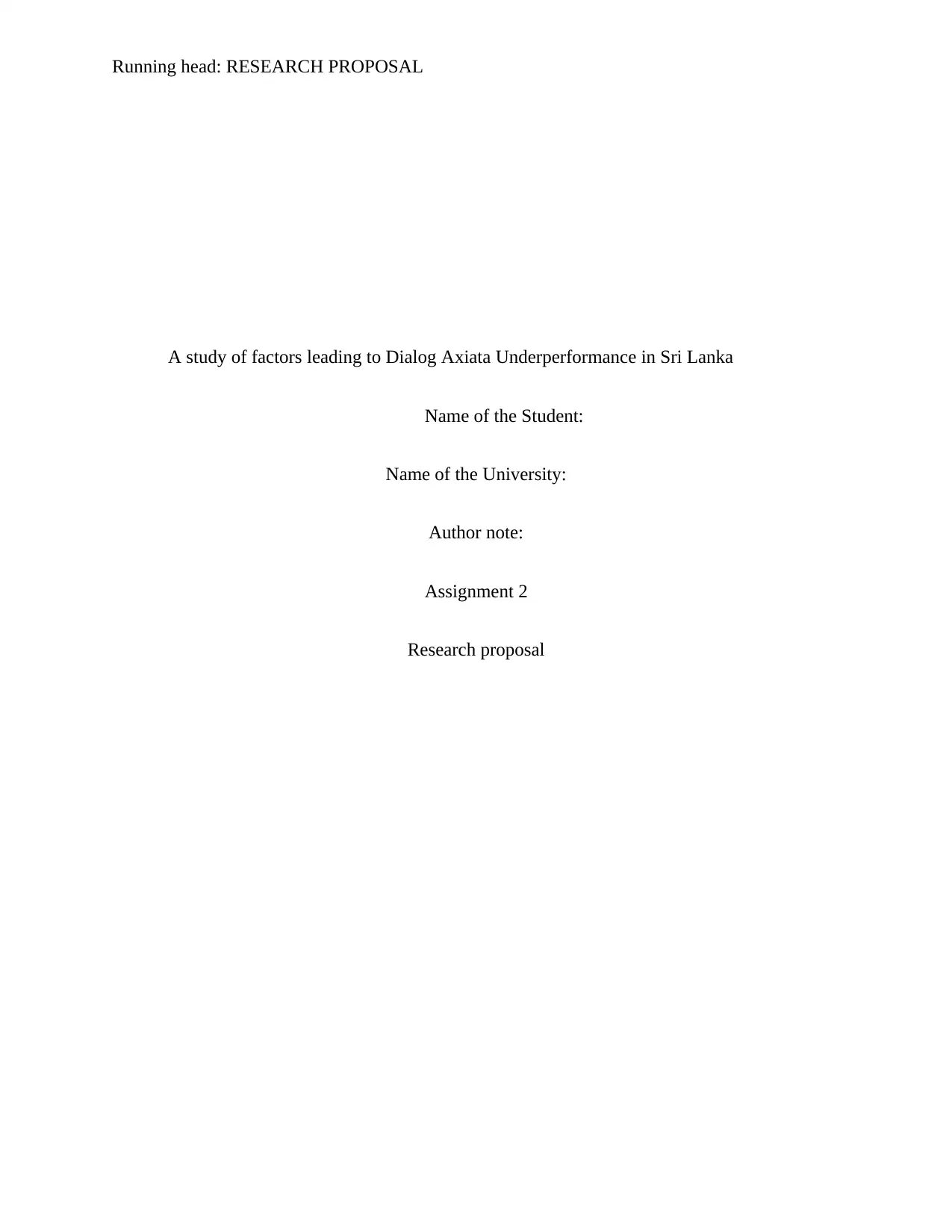
Running head: RESEARCH PROPOSAL
A study of factors leading to Dialog Axiata Underperformance in Sri Lanka
Name of the Student:
Name of the University:
Author note:
Assignment 2
Research proposal
A study of factors leading to Dialog Axiata Underperformance in Sri Lanka
Name of the Student:
Name of the University:
Author note:
Assignment 2
Research proposal
Paraphrase This Document
Need a fresh take? Get an instant paraphrase of this document with our AI Paraphraser
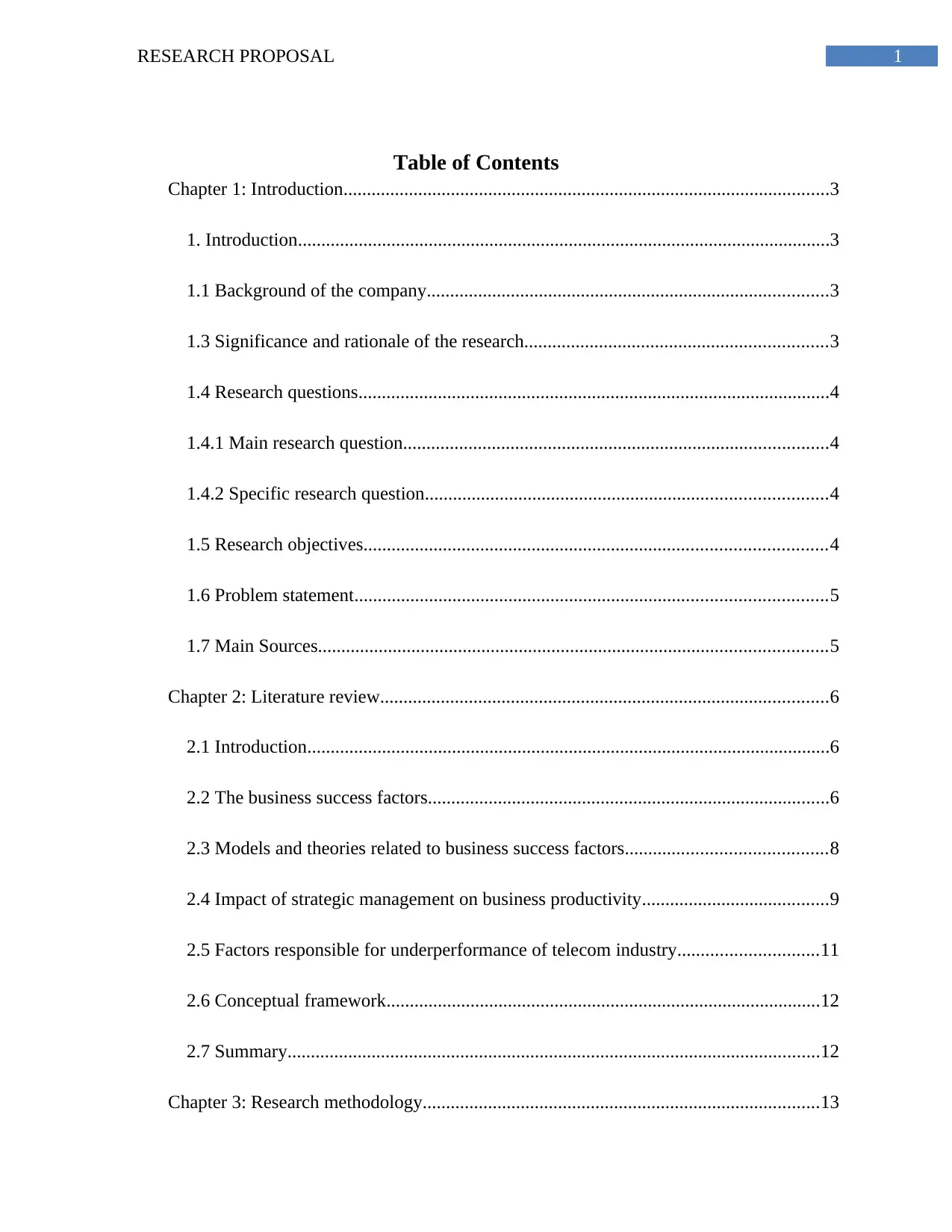
1RESEARCH PROPOSAL
Table of Contents
Chapter 1: Introduction........................................................................................................3
1. Introduction..................................................................................................................3
1.1 Background of the company......................................................................................3
1.3 Significance and rationale of the research.................................................................3
1.4 Research questions.....................................................................................................4
1.4.1 Main research question...........................................................................................4
1.4.2 Specific research question......................................................................................4
1.5 Research objectives...................................................................................................4
1.6 Problem statement.....................................................................................................5
1.7 Main Sources.............................................................................................................5
Chapter 2: Literature review................................................................................................6
2.1 Introduction................................................................................................................6
2.2 The business success factors......................................................................................6
2.3 Models and theories related to business success factors...........................................8
2.4 Impact of strategic management on business productivity........................................9
2.5 Factors responsible for underperformance of telecom industry..............................11
2.6 Conceptual framework.............................................................................................12
2.7 Summary..................................................................................................................12
Chapter 3: Research methodology.....................................................................................13
Table of Contents
Chapter 1: Introduction........................................................................................................3
1. Introduction..................................................................................................................3
1.1 Background of the company......................................................................................3
1.3 Significance and rationale of the research.................................................................3
1.4 Research questions.....................................................................................................4
1.4.1 Main research question...........................................................................................4
1.4.2 Specific research question......................................................................................4
1.5 Research objectives...................................................................................................4
1.6 Problem statement.....................................................................................................5
1.7 Main Sources.............................................................................................................5
Chapter 2: Literature review................................................................................................6
2.1 Introduction................................................................................................................6
2.2 The business success factors......................................................................................6
2.3 Models and theories related to business success factors...........................................8
2.4 Impact of strategic management on business productivity........................................9
2.5 Factors responsible for underperformance of telecom industry..............................11
2.6 Conceptual framework.............................................................................................12
2.7 Summary..................................................................................................................12
Chapter 3: Research methodology.....................................................................................13
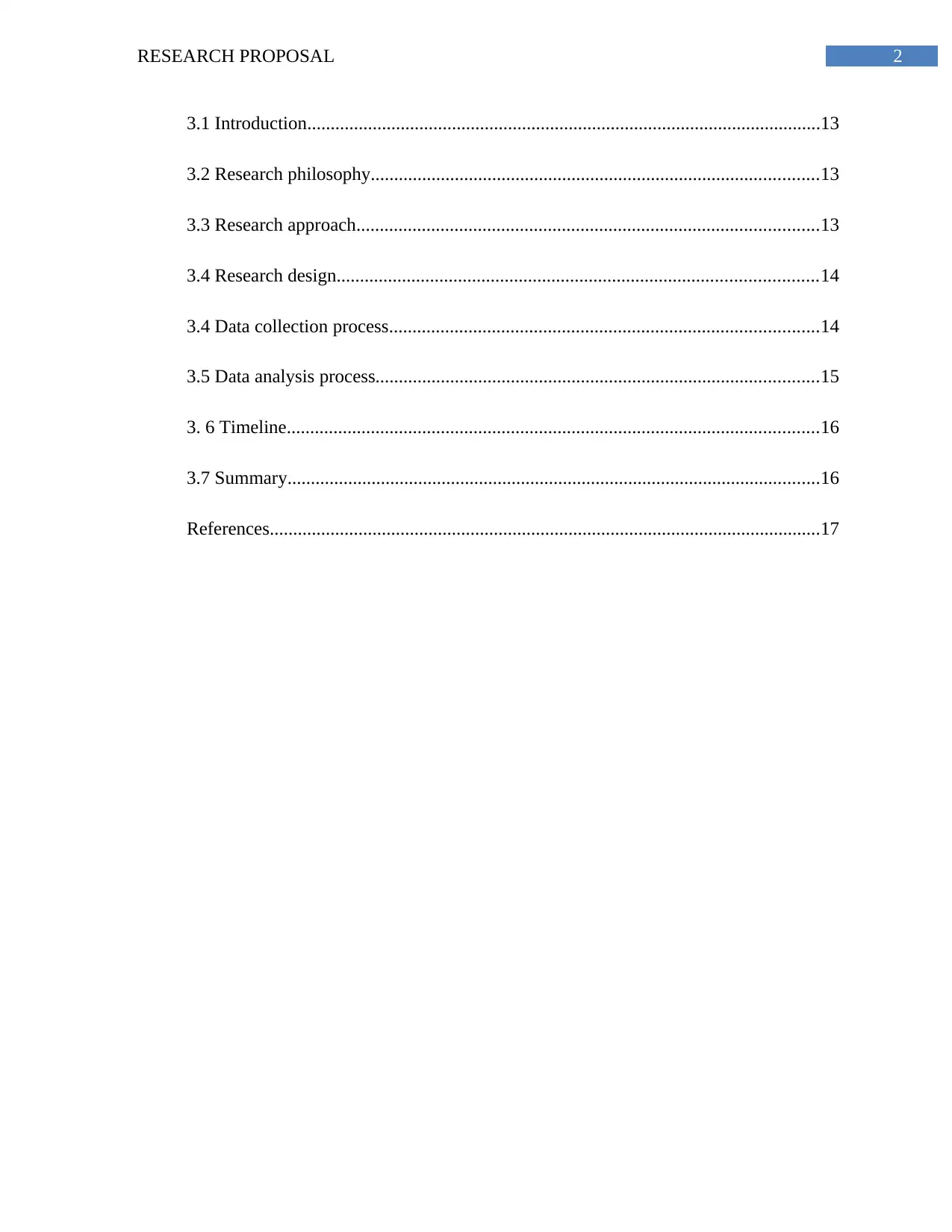
2RESEARCH PROPOSAL
3.1 Introduction..............................................................................................................13
3.2 Research philosophy................................................................................................13
3.3 Research approach...................................................................................................13
3.4 Research design.......................................................................................................14
3.4 Data collection process............................................................................................14
3.5 Data analysis process...............................................................................................15
3. 6 Timeline..................................................................................................................16
3.7 Summary..................................................................................................................16
References......................................................................................................................17
3.1 Introduction..............................................................................................................13
3.2 Research philosophy................................................................................................13
3.3 Research approach...................................................................................................13
3.4 Research design.......................................................................................................14
3.4 Data collection process............................................................................................14
3.5 Data analysis process...............................................................................................15
3. 6 Timeline..................................................................................................................16
3.7 Summary..................................................................................................................16
References......................................................................................................................17
⊘ This is a preview!⊘
Do you want full access?
Subscribe today to unlock all pages.

Trusted by 1+ million students worldwide

3RESEARCH PROPOSAL
Chapter 1: Introduction
1. Introduction
1.1 Background of the company
Dialog Axiata is the largest as well as fastest growing telecommunication company in Sri
Lanka. It is one of the major subsidiaries of Axiata Group Berhad. The mobile industry of Sri
Lanka has achieved several new heights as well as come with developed world. The telecom
organization operates 3G and 4G services that supports. The present trends in multimedia as well
as internet services and international roaming are important to be considered in this aspect. In
addition, the company accounts more than 50% mobile network subscribers in Sri Lanka. The
company is the largest Foreign Director Investors with the investment more than USD 1.7 billion
(Thilakarathne and Abeysekera 2016). The organization is also an owned subsidiary and a
significant player in the infrastructure of Sri Lanka.
1.3 Significance and rationale of the research
The telecommunication industry of Sri Lanka has been in its maturity stage. Dialog
Axiata had 50% of market share in the market position, whereas other competitors are Mobitel,
Etisalat as well as Hutch shared the rest of the market in 2008. It results privatizations of all
market shares of the competitors and started increasing gradually. On the other hand, after
introduction of GSM to the market, Dialog Axiata had been able to gain profit than previous
years. However, the competitors were not competitor at that time as Dialog Axiata was
unbeatable in the market position. In this perspective, the organization has started competing
with each other while developing a considerable profit (Elshaikh et al. 2018). On the other hand,
Chapter 1: Introduction
1. Introduction
1.1 Background of the company
Dialog Axiata is the largest as well as fastest growing telecommunication company in Sri
Lanka. It is one of the major subsidiaries of Axiata Group Berhad. The mobile industry of Sri
Lanka has achieved several new heights as well as come with developed world. The telecom
organization operates 3G and 4G services that supports. The present trends in multimedia as well
as internet services and international roaming are important to be considered in this aspect. In
addition, the company accounts more than 50% mobile network subscribers in Sri Lanka. The
company is the largest Foreign Director Investors with the investment more than USD 1.7 billion
(Thilakarathne and Abeysekera 2016). The organization is also an owned subsidiary and a
significant player in the infrastructure of Sri Lanka.
1.3 Significance and rationale of the research
The telecommunication industry of Sri Lanka has been in its maturity stage. Dialog
Axiata had 50% of market share in the market position, whereas other competitors are Mobitel,
Etisalat as well as Hutch shared the rest of the market in 2008. It results privatizations of all
market shares of the competitors and started increasing gradually. On the other hand, after
introduction of GSM to the market, Dialog Axiata had been able to gain profit than previous
years. However, the competitors were not competitor at that time as Dialog Axiata was
unbeatable in the market position. In this perspective, the organization has started competing
with each other while developing a considerable profit (Elshaikh et al. 2018). On the other hand,
Paraphrase This Document
Need a fresh take? Get an instant paraphrase of this document with our AI Paraphraser

4RESEARCH PROPOSAL
the telecom industry of Sri Lanka has faced a remarkable change in 2009. One of the causes was
launching of Airtel with a massive number of customer base. Airtel and Emirates have occupied
the positions of the best innovators. In addition, the competitors were able to provide signal
coverage across the island. Hence, the organization was not able to sustain in the market with
respective position.
In order to attain sustainability, it became essential attracting new consumers and retains
them for long time. Since, there are any changes in the products as well as service; there is a high
opportunity that the customers switch from a place to another whether it does not satisfy the
customers (Samarajiva and Hurulle 2017). Hence, loyalty of the customers has an important role.
Thus, it is important to analyze the factors that are responsible for the underperformance of
Dialog Axiata.
1.4 Research questions
1.4.1 Main research question
The research questions can be explained as followed.
What are the factors responsible for underperformance of Dialog Axiata?
How the issues faced by Dialog Axiata can be resolved?
1.4.2 Specific research question
What are the factors responsible for underperformance of Dialog Axiata?
1.5 Research objectives
The research objectives can be listed as followed.
To analyze the factors responsible for underperformance of Dialog Axiata
the telecom industry of Sri Lanka has faced a remarkable change in 2009. One of the causes was
launching of Airtel with a massive number of customer base. Airtel and Emirates have occupied
the positions of the best innovators. In addition, the competitors were able to provide signal
coverage across the island. Hence, the organization was not able to sustain in the market with
respective position.
In order to attain sustainability, it became essential attracting new consumers and retains
them for long time. Since, there are any changes in the products as well as service; there is a high
opportunity that the customers switch from a place to another whether it does not satisfy the
customers (Samarajiva and Hurulle 2017). Hence, loyalty of the customers has an important role.
Thus, it is important to analyze the factors that are responsible for the underperformance of
Dialog Axiata.
1.4 Research questions
1.4.1 Main research question
The research questions can be explained as followed.
What are the factors responsible for underperformance of Dialog Axiata?
How the issues faced by Dialog Axiata can be resolved?
1.4.2 Specific research question
What are the factors responsible for underperformance of Dialog Axiata?
1.5 Research objectives
The research objectives can be listed as followed.
To analyze the factors responsible for underperformance of Dialog Axiata

5RESEARCH PROPOSAL
To recommend solutions for overcoming the issues
1.6 Problem statement
(Wang et al. 2017). Dialog has been able dominating the telecommunication sector for
the past decade for continuous innovations as well as use of the latest technologies in the service
package. However, strategic management models deployed at Dialog Axiata face some issues
and resulting underperformance
1.7 Main Sources
It is important to identify the sources from where the data are collected. In the present
study, the data will be collected from relevant secondary sources such as books, journals and
websites. The annual reports published by the organization will be selected as the main source of
the data collection.
To recommend solutions for overcoming the issues
1.6 Problem statement
(Wang et al. 2017). Dialog has been able dominating the telecommunication sector for
the past decade for continuous innovations as well as use of the latest technologies in the service
package. However, strategic management models deployed at Dialog Axiata face some issues
and resulting underperformance
1.7 Main Sources
It is important to identify the sources from where the data are collected. In the present
study, the data will be collected from relevant secondary sources such as books, journals and
websites. The annual reports published by the organization will be selected as the main source of
the data collection.
⊘ This is a preview!⊘
Do you want full access?
Subscribe today to unlock all pages.

Trusted by 1+ million students worldwide
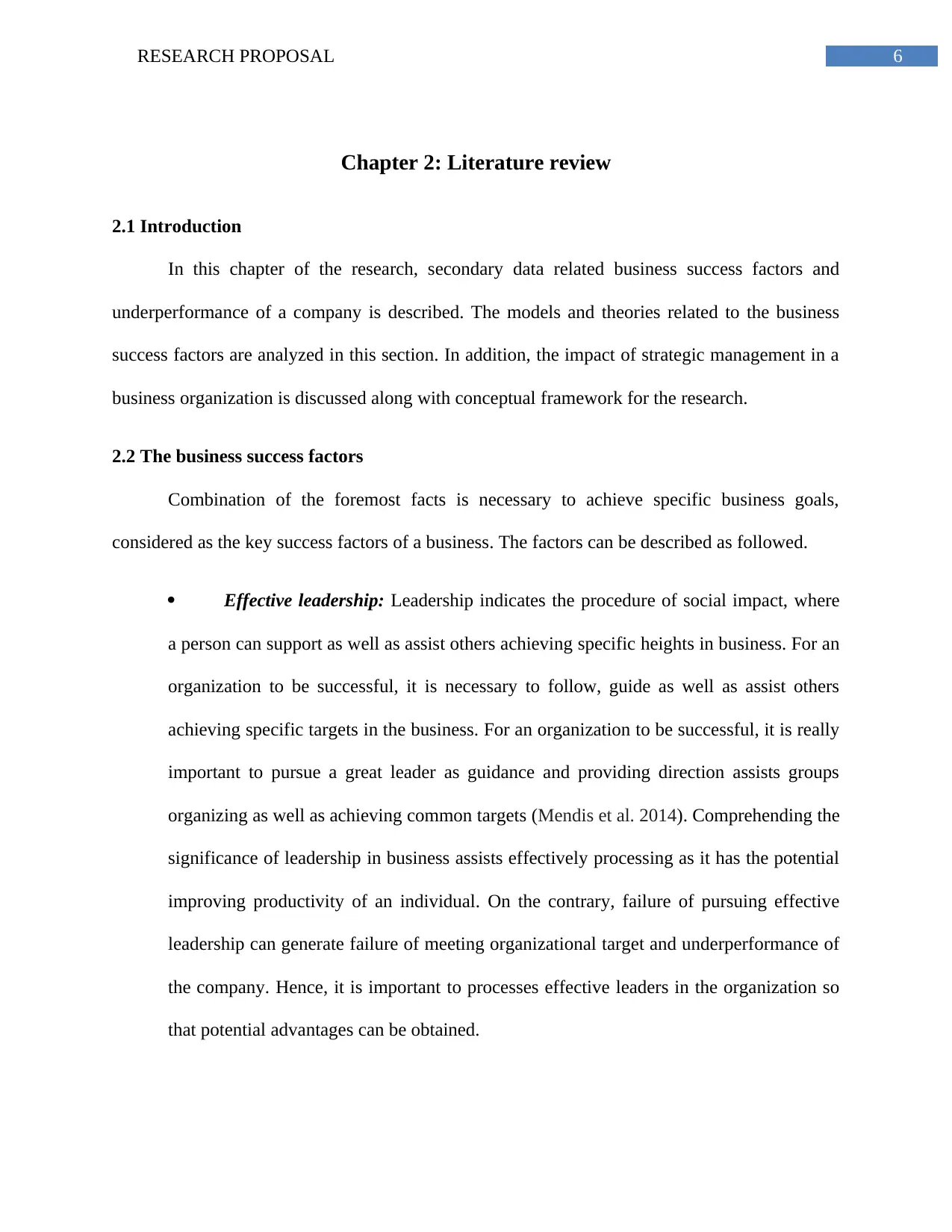
6RESEARCH PROPOSAL
Chapter 2: Literature review
2.1 Introduction
In this chapter of the research, secondary data related business success factors and
underperformance of a company is described. The models and theories related to the business
success factors are analyzed in this section. In addition, the impact of strategic management in a
business organization is discussed along with conceptual framework for the research.
2.2 The business success factors
Combination of the foremost facts is necessary to achieve specific business goals,
considered as the key success factors of a business. The factors can be described as followed.
Effective leadership: Leadership indicates the procedure of social impact, where
a person can support as well as assist others achieving specific heights in business. For an
organization to be successful, it is necessary to follow, guide as well as assist others
achieving specific targets in the business. For an organization to be successful, it is really
important to pursue a great leader as guidance and providing direction assists groups
organizing as well as achieving common targets (Mendis et al. 2014). Comprehending the
significance of leadership in business assists effectively processing as it has the potential
improving productivity of an individual. On the contrary, failure of pursuing effective
leadership can generate failure of meeting organizational target and underperformance of
the company. Hence, it is important to processes effective leaders in the organization so
that potential advantages can be obtained.
Chapter 2: Literature review
2.1 Introduction
In this chapter of the research, secondary data related business success factors and
underperformance of a company is described. The models and theories related to the business
success factors are analyzed in this section. In addition, the impact of strategic management in a
business organization is discussed along with conceptual framework for the research.
2.2 The business success factors
Combination of the foremost facts is necessary to achieve specific business goals,
considered as the key success factors of a business. The factors can be described as followed.
Effective leadership: Leadership indicates the procedure of social impact, where
a person can support as well as assist others achieving specific heights in business. For an
organization to be successful, it is necessary to follow, guide as well as assist others
achieving specific targets in the business. For an organization to be successful, it is really
important to pursue a great leader as guidance and providing direction assists groups
organizing as well as achieving common targets (Mendis et al. 2014). Comprehending the
significance of leadership in business assists effectively processing as it has the potential
improving productivity of an individual. On the contrary, failure of pursuing effective
leadership can generate failure of meeting organizational target and underperformance of
the company. Hence, it is important to processes effective leaders in the organization so
that potential advantages can be obtained.
Paraphrase This Document
Need a fresh take? Get an instant paraphrase of this document with our AI Paraphraser
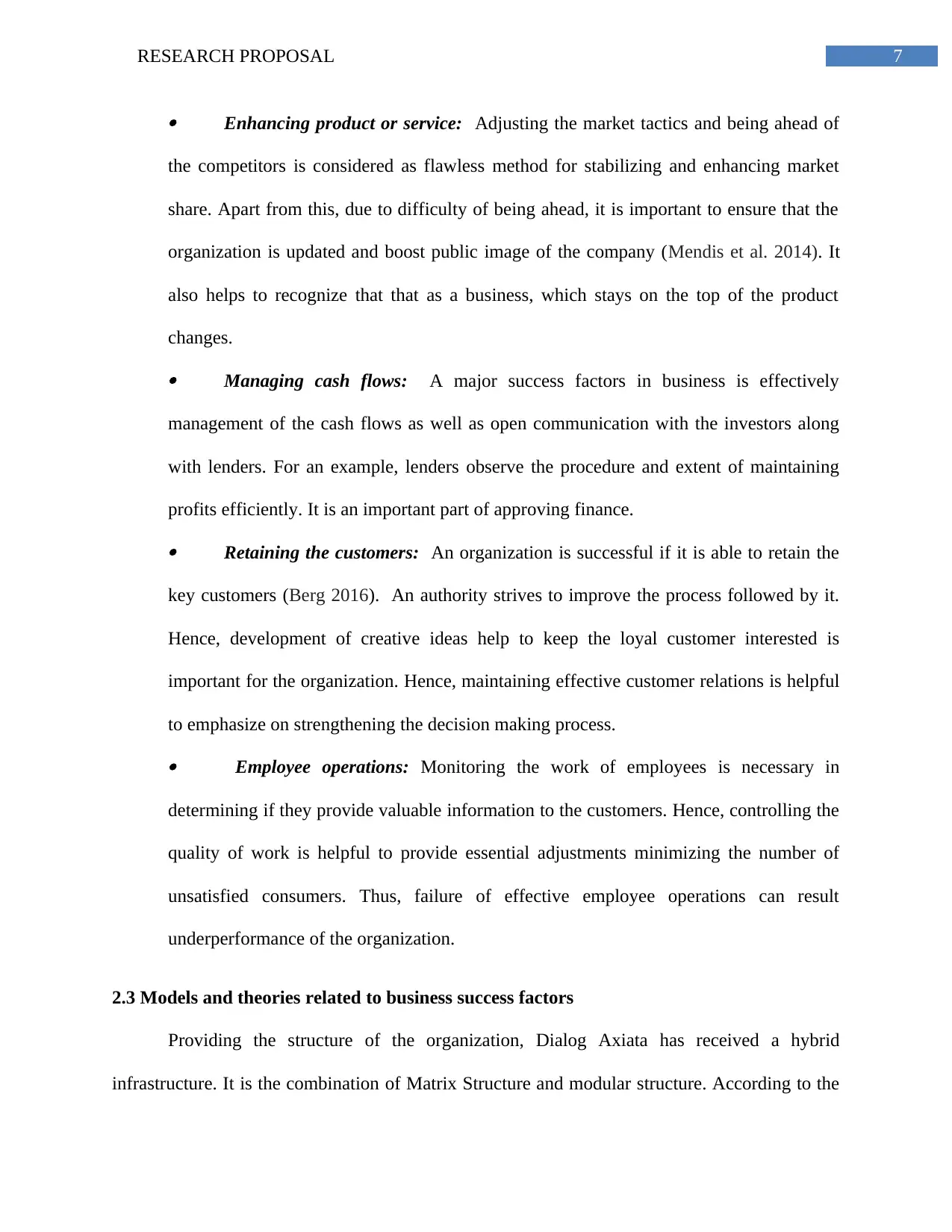
7RESEARCH PROPOSAL
Enhancing product or service: Adjusting the market tactics and being ahead of
the competitors is considered as flawless method for stabilizing and enhancing market
share. Apart from this, due to difficulty of being ahead, it is important to ensure that the
organization is updated and boost public image of the company (Mendis et al. 2014). It
also helps to recognize that that as a business, which stays on the top of the product
changes. Managing cash flows: A major success factors in business is effectively
management of the cash flows as well as open communication with the investors along
with lenders. For an example, lenders observe the procedure and extent of maintaining
profits efficiently. It is an important part of approving finance. Retaining the customers: An organization is successful if it is able to retain the
key customers (Berg 2016). An authority strives to improve the process followed by it.
Hence, development of creative ideas help to keep the loyal customer interested is
important for the organization. Hence, maintaining effective customer relations is helpful
to emphasize on strengthening the decision making process. Employee operations: Monitoring the work of employees is necessary in
determining if they provide valuable information to the customers. Hence, controlling the
quality of work is helpful to provide essential adjustments minimizing the number of
unsatisfied consumers. Thus, failure of effective employee operations can result
underperformance of the organization.
2.3 Models and theories related to business success factors
Providing the structure of the organization, Dialog Axiata has received a hybrid
infrastructure. It is the combination of Matrix Structure and modular structure. According to the
Enhancing product or service: Adjusting the market tactics and being ahead of
the competitors is considered as flawless method for stabilizing and enhancing market
share. Apart from this, due to difficulty of being ahead, it is important to ensure that the
organization is updated and boost public image of the company (Mendis et al. 2014). It
also helps to recognize that that as a business, which stays on the top of the product
changes. Managing cash flows: A major success factors in business is effectively
management of the cash flows as well as open communication with the investors along
with lenders. For an example, lenders observe the procedure and extent of maintaining
profits efficiently. It is an important part of approving finance. Retaining the customers: An organization is successful if it is able to retain the
key customers (Berg 2016). An authority strives to improve the process followed by it.
Hence, development of creative ideas help to keep the loyal customer interested is
important for the organization. Hence, maintaining effective customer relations is helpful
to emphasize on strengthening the decision making process. Employee operations: Monitoring the work of employees is necessary in
determining if they provide valuable information to the customers. Hence, controlling the
quality of work is helpful to provide essential adjustments minimizing the number of
unsatisfied consumers. Thus, failure of effective employee operations can result
underperformance of the organization.
2.3 Models and theories related to business success factors
Providing the structure of the organization, Dialog Axiata has received a hybrid
infrastructure. It is the combination of Matrix Structure and modular structure. According to the
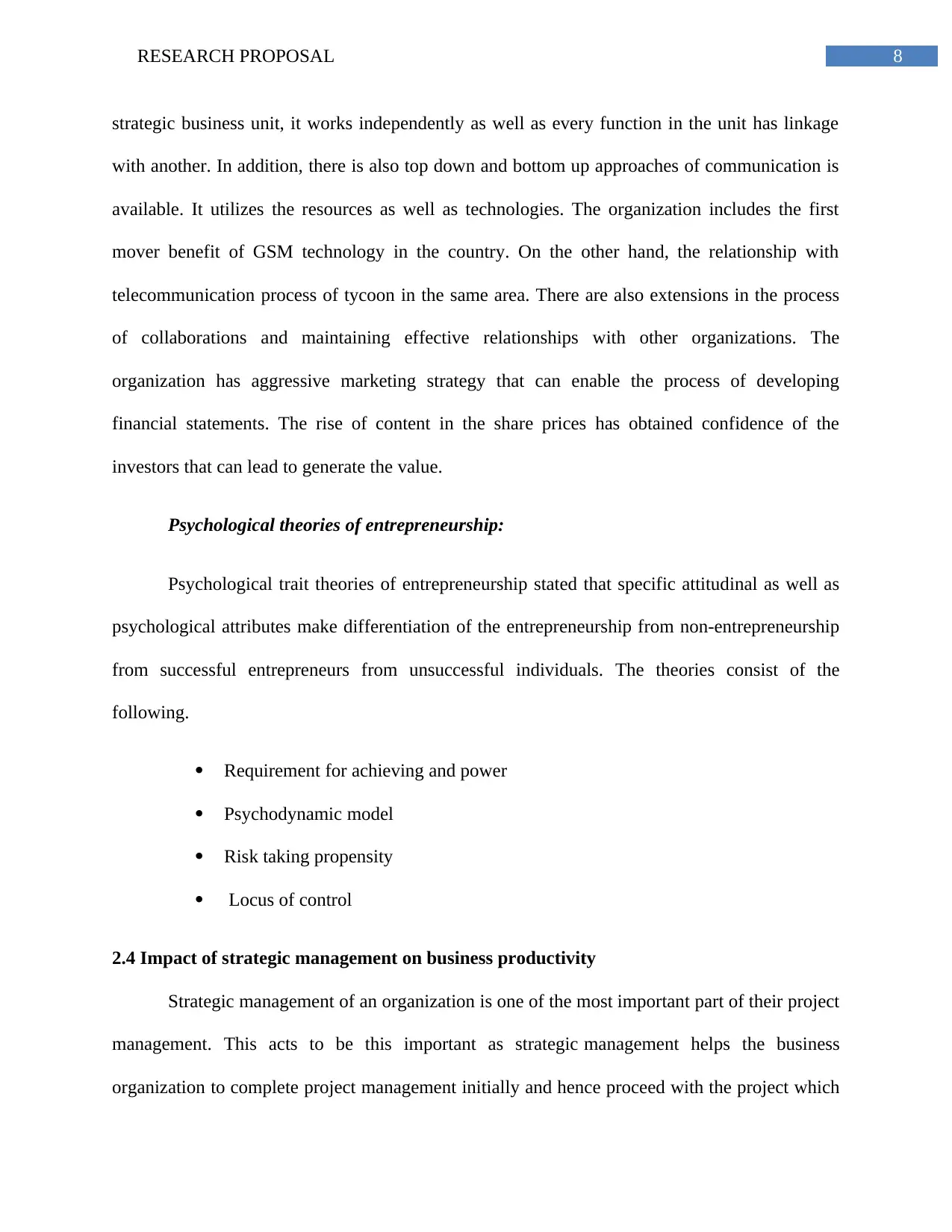
8RESEARCH PROPOSAL
strategic business unit, it works independently as well as every function in the unit has linkage
with another. In addition, there is also top down and bottom up approaches of communication is
available. It utilizes the resources as well as technologies. The organization includes the first
mover benefit of GSM technology in the country. On the other hand, the relationship with
telecommunication process of tycoon in the same area. There are also extensions in the process
of collaborations and maintaining effective relationships with other organizations. The
organization has aggressive marketing strategy that can enable the process of developing
financial statements. The rise of content in the share prices has obtained confidence of the
investors that can lead to generate the value.
Psychological theories of entrepreneurship:
Psychological trait theories of entrepreneurship stated that specific attitudinal as well as
psychological attributes make differentiation of the entrepreneurship from non-entrepreneurship
from successful entrepreneurs from unsuccessful individuals. The theories consist of the
following.
Requirement for achieving and power
Psychodynamic model
Risk taking propensity
Locus of control
2.4 Impact of strategic management on business productivity
Strategic management of an organization is one of the most important part of their project
management. This acts to be this important as strategic management helps the business
organization to complete project management initially and hence proceed with the project which
strategic business unit, it works independently as well as every function in the unit has linkage
with another. In addition, there is also top down and bottom up approaches of communication is
available. It utilizes the resources as well as technologies. The organization includes the first
mover benefit of GSM technology in the country. On the other hand, the relationship with
telecommunication process of tycoon in the same area. There are also extensions in the process
of collaborations and maintaining effective relationships with other organizations. The
organization has aggressive marketing strategy that can enable the process of developing
financial statements. The rise of content in the share prices has obtained confidence of the
investors that can lead to generate the value.
Psychological theories of entrepreneurship:
Psychological trait theories of entrepreneurship stated that specific attitudinal as well as
psychological attributes make differentiation of the entrepreneurship from non-entrepreneurship
from successful entrepreneurs from unsuccessful individuals. The theories consist of the
following.
Requirement for achieving and power
Psychodynamic model
Risk taking propensity
Locus of control
2.4 Impact of strategic management on business productivity
Strategic management of an organization is one of the most important part of their project
management. This acts to be this important as strategic management helps the business
organization to complete project management initially and hence proceed with the project which
⊘ This is a preview!⊘
Do you want full access?
Subscribe today to unlock all pages.

Trusted by 1+ million students worldwide
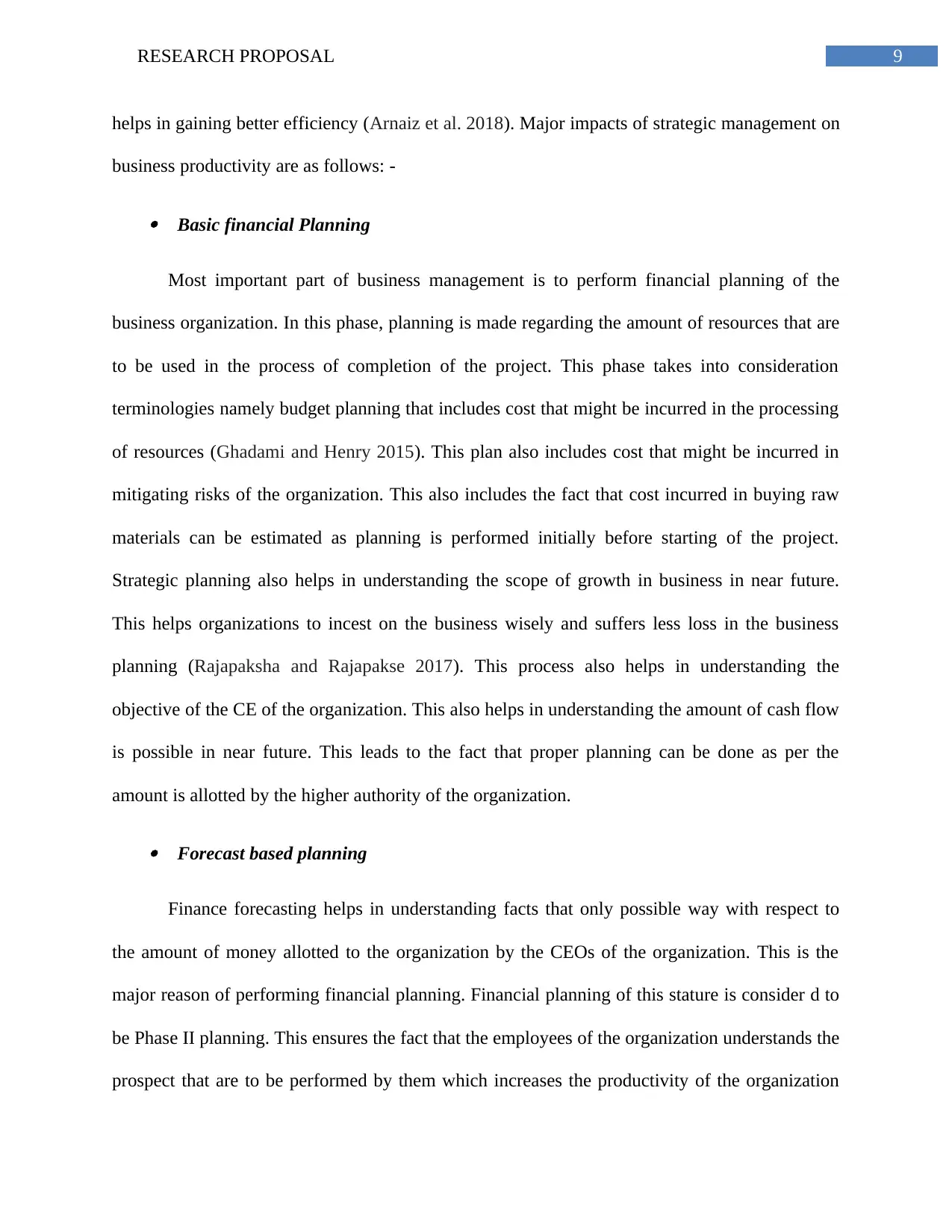
9RESEARCH PROPOSAL
helps in gaining better efficiency (Arnaiz et al. 2018). Major impacts of strategic management on
business productivity are as follows: -
Basic financial Planning
Most important part of business management is to perform financial planning of the
business organization. In this phase, planning is made regarding the amount of resources that are
to be used in the process of completion of the project. This phase takes into consideration
terminologies namely budget planning that includes cost that might be incurred in the processing
of resources (Ghadami and Henry 2015). This plan also includes cost that might be incurred in
mitigating risks of the organization. This also includes the fact that cost incurred in buying raw
materials can be estimated as planning is performed initially before starting of the project.
Strategic planning also helps in understanding the scope of growth in business in near future.
This helps organizations to incest on the business wisely and suffers less loss in the business
planning (Rajapaksha and Rajapakse 2017). This process also helps in understanding the
objective of the CE of the organization. This also helps in understanding the amount of cash flow
is possible in near future. This leads to the fact that proper planning can be done as per the
amount is allotted by the higher authority of the organization.
Forecast based planning
Finance forecasting helps in understanding facts that only possible way with respect to
the amount of money allotted to the organization by the CEOs of the organization. This is the
major reason of performing financial planning. Financial planning of this stature is consider d to
be Phase II planning. This ensures the fact that the employees of the organization understands the
prospect that are to be performed by them which increases the productivity of the organization
helps in gaining better efficiency (Arnaiz et al. 2018). Major impacts of strategic management on
business productivity are as follows: -
Basic financial Planning
Most important part of business management is to perform financial planning of the
business organization. In this phase, planning is made regarding the amount of resources that are
to be used in the process of completion of the project. This phase takes into consideration
terminologies namely budget planning that includes cost that might be incurred in the processing
of resources (Ghadami and Henry 2015). This plan also includes cost that might be incurred in
mitigating risks of the organization. This also includes the fact that cost incurred in buying raw
materials can be estimated as planning is performed initially before starting of the project.
Strategic planning also helps in understanding the scope of growth in business in near future.
This helps organizations to incest on the business wisely and suffers less loss in the business
planning (Rajapaksha and Rajapakse 2017). This process also helps in understanding the
objective of the CE of the organization. This also helps in understanding the amount of cash flow
is possible in near future. This leads to the fact that proper planning can be done as per the
amount is allotted by the higher authority of the organization.
Forecast based planning
Finance forecasting helps in understanding facts that only possible way with respect to
the amount of money allotted to the organization by the CEOs of the organization. This is the
major reason of performing financial planning. Financial planning of this stature is consider d to
be Phase II planning. This ensures the fact that the employees of the organization understands the
prospect that are to be performed by them which increases the productivity of the organization
Paraphrase This Document
Need a fresh take? Get an instant paraphrase of this document with our AI Paraphraser

10RESEARCH PROPOSAL
which in turn increases the turn-over of the organization. Complexities that might arose in the
processing of the business can be understood, leading to the fact that steps that will be taken will
be decided (Brusset 2016). This leads to mitigation if risks and wastage of raw resources and raw
materials that incurs a high cost. Financial management includes tools that considers the
evaluated results of surveys that are conducted. This helps in trend analyzing. This is the major
reason that financial management is performed in order to understand the requirement and
demands of the global audience.
Dynamic performance
Financial management takes into consideration the fact that in near future, the entre
scenario might change, leading to the fact that all plans that are created in the processing of data
analysis can be altered any time in near future. This acts robustness to the plan and decision
making ideas (Athukorala and Wongsurawat 2014). This is the only reason that financial
management is preferred over other. This is the reason that dynamicity of the entire project is
maintained. This increases the efficiency of the project. This is the reason that financial
management helps in making the project planning more versatile.
2.5 Factors responsible for underperformance of telecom industry
Major facts that affects the underperformance of a telecommunication company are as
follows: -
Lack of transparency
Transparency is one of the most important prospect of an organization. This helps in
avoiding misunderstanding between the employees of the organization. This is also another
reason that deals with the fact that prosecution and communication in between the higher
which in turn increases the turn-over of the organization. Complexities that might arose in the
processing of the business can be understood, leading to the fact that steps that will be taken will
be decided (Brusset 2016). This leads to mitigation if risks and wastage of raw resources and raw
materials that incurs a high cost. Financial management includes tools that considers the
evaluated results of surveys that are conducted. This helps in trend analyzing. This is the major
reason that financial management is performed in order to understand the requirement and
demands of the global audience.
Dynamic performance
Financial management takes into consideration the fact that in near future, the entre
scenario might change, leading to the fact that all plans that are created in the processing of data
analysis can be altered any time in near future. This acts robustness to the plan and decision
making ideas (Athukorala and Wongsurawat 2014). This is the only reason that financial
management is preferred over other. This is the reason that dynamicity of the entire project is
maintained. This increases the efficiency of the project. This is the reason that financial
management helps in making the project planning more versatile.
2.5 Factors responsible for underperformance of telecom industry
Major facts that affects the underperformance of a telecommunication company are as
follows: -
Lack of transparency
Transparency is one of the most important prospect of an organization. This helps in
avoiding misunderstanding between the employees of the organization. This is also another
reason that deals with the fact that prosecution and communication in between the higher
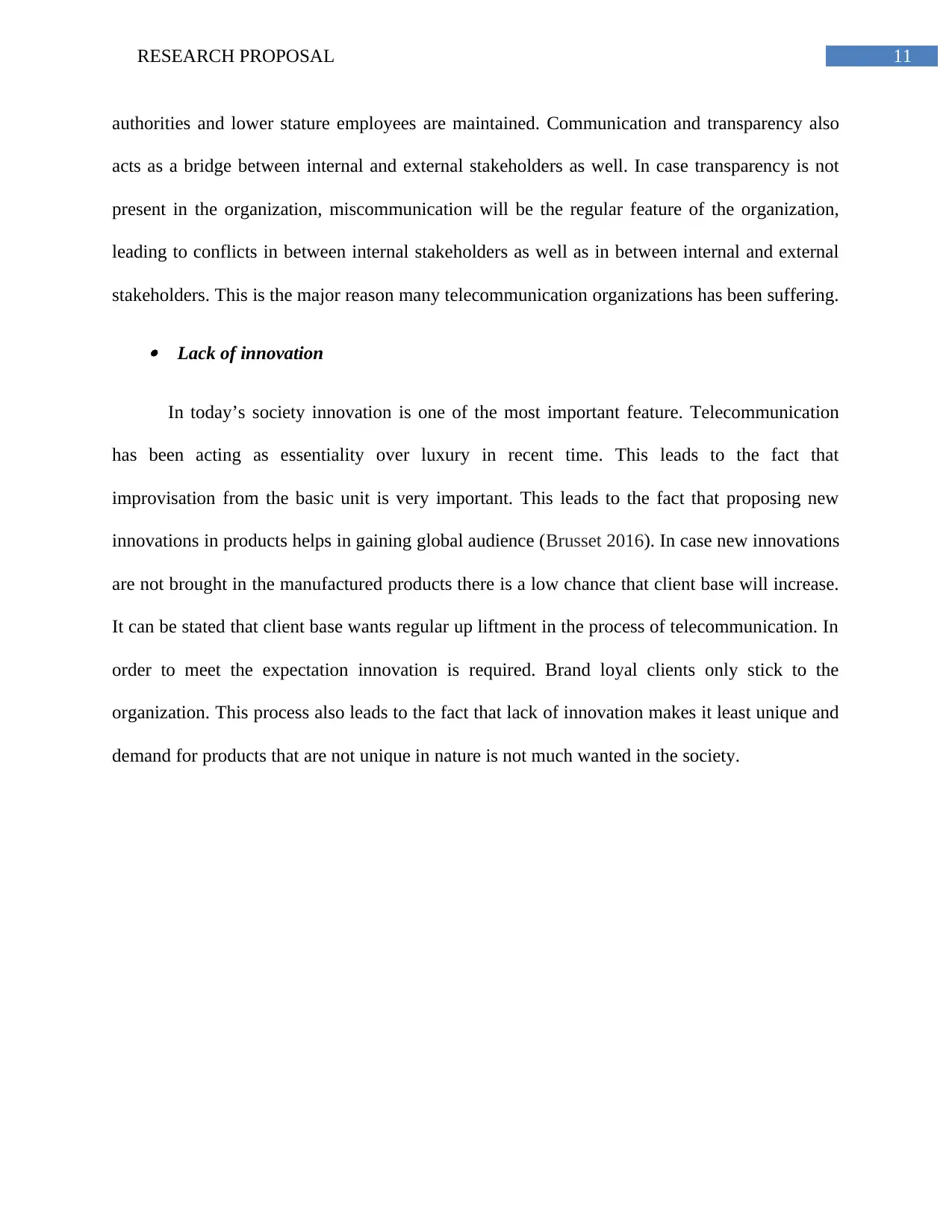
11RESEARCH PROPOSAL
authorities and lower stature employees are maintained. Communication and transparency also
acts as a bridge between internal and external stakeholders as well. In case transparency is not
present in the organization, miscommunication will be the regular feature of the organization,
leading to conflicts in between internal stakeholders as well as in between internal and external
stakeholders. This is the major reason many telecommunication organizations has been suffering.
Lack of innovation
In today’s society innovation is one of the most important feature. Telecommunication
has been acting as essentiality over luxury in recent time. This leads to the fact that
improvisation from the basic unit is very important. This leads to the fact that proposing new
innovations in products helps in gaining global audience (Brusset 2016). In case new innovations
are not brought in the manufactured products there is a low chance that client base will increase.
It can be stated that client base wants regular up liftment in the process of telecommunication. In
order to meet the expectation innovation is required. Brand loyal clients only stick to the
organization. This process also leads to the fact that lack of innovation makes it least unique and
demand for products that are not unique in nature is not much wanted in the society.
authorities and lower stature employees are maintained. Communication and transparency also
acts as a bridge between internal and external stakeholders as well. In case transparency is not
present in the organization, miscommunication will be the regular feature of the organization,
leading to conflicts in between internal stakeholders as well as in between internal and external
stakeholders. This is the major reason many telecommunication organizations has been suffering.
Lack of innovation
In today’s society innovation is one of the most important feature. Telecommunication
has been acting as essentiality over luxury in recent time. This leads to the fact that
improvisation from the basic unit is very important. This leads to the fact that proposing new
innovations in products helps in gaining global audience (Brusset 2016). In case new innovations
are not brought in the manufactured products there is a low chance that client base will increase.
It can be stated that client base wants regular up liftment in the process of telecommunication. In
order to meet the expectation innovation is required. Brand loyal clients only stick to the
organization. This process also leads to the fact that lack of innovation makes it least unique and
demand for products that are not unique in nature is not much wanted in the society.
⊘ This is a preview!⊘
Do you want full access?
Subscribe today to unlock all pages.

Trusted by 1+ million students worldwide
1 out of 20
Related Documents
Your All-in-One AI-Powered Toolkit for Academic Success.
+13062052269
info@desklib.com
Available 24*7 on WhatsApp / Email
![[object Object]](/_next/static/media/star-bottom.7253800d.svg)
Unlock your academic potential
Copyright © 2020–2025 A2Z Services. All Rights Reserved. Developed and managed by ZUCOL.





